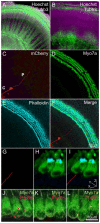Single-Cell Transcriptome Analysis of Developing and Regenerating Spiral Ganglion Neurons
- PMID: 28758056
- PMCID: PMC5531199
- DOI: 10.1007/s40495-016-0064-z
Single-Cell Transcriptome Analysis of Developing and Regenerating Spiral Ganglion Neurons
Abstract
The spiral ganglion neurons (SGNs) of the cochlea are essential for our ability to hear. SGN loss after exposure to ototoxic drugs or loud noise results in hearing loss. Pluripotent stem cell-derived and endogenous progenitor cell types have the potential to become SGNs and are cellular foundations for replacement therapies. Repurposing transcriptional regulatory networks to promote SGN differentiation from progenitor cells is a strategy for regeneration. Advances in the Fludigm C1 workflow or Drop-seq allow sequencing of single cell transcriptomes to reveal variability between cells. During differentiation, the individual transcriptomes obtained from single-cell RNA-seq can be exploited to identify different cellular states. Pseudotemporal ordering of transcriptomes describes the differentiation trajectory, allows monitoring of transcriptional changes and determines molecular barriers that prevent the progression of progenitors into SGNs. Analysis of single cell transcriptomes will help develop novel strategies for guiding efficient SGN regeneration.
Figures

Similar articles
-
Regulation of Spiral Ganglion Neuron Regeneration as a Therapeutic Strategy in Sensorineural Hearing Loss.Front Mol Neurosci. 2022 Jan 20;14:829564. doi: 10.3389/fnmol.2021.829564. eCollection 2021. Front Mol Neurosci. 2022. PMID: 35126054 Free PMC article. Review.
-
Mechanism and Prevention of Spiral Ganglion Neuron Degeneration in the Cochlea.Front Cell Neurosci. 2022 Jan 5;15:814891. doi: 10.3389/fncel.2021.814891. eCollection 2021. Front Cell Neurosci. 2022. PMID: 35069120 Free PMC article. Review.
-
Valproic acid promotes the neuronal differentiation of spiral ganglion neural stem cells with robust axonal growth.Biochem Biophys Res Commun. 2018 Sep 18;503(4):2728-2735. doi: 10.1016/j.bbrc.2018.08.032. Epub 2018 Aug 16. Biochem Biophys Res Commun. 2018. PMID: 30119886
-
Wnt Signaling Activates TP53-Induced Glycolysis and Apoptosis Regulator and Protects Against Cisplatin-Induced Spiral Ganglion Neuron Damage in the Mouse Cochlea.Antioxid Redox Signal. 2019 Apr 10;30(11):1389-1410. doi: 10.1089/ars.2017.7288. Epub 2018 May 4. Antioxid Redox Signal. 2019. PMID: 29587485
-
Single-Cell Fluorescence Analysis of Pseudotemporal Ordered Cells Provides Protein Expression Dynamics for Neuronal Differentiation.Front Cell Dev Biol. 2019 May 29;7:87. doi: 10.3389/fcell.2019.00087. eCollection 2019. Front Cell Dev Biol. 2019. PMID: 31192206 Free PMC article.
Cited by
-
Wnt signalling facilitates neuronal differentiation of cochlear Frizzled10-positive cells in mouse cochlea via glypican 6 modulation.Cell Commun Signal. 2025 Jan 27;23(1):50. doi: 10.1186/s12964-025-02039-9. Cell Commun Signal. 2025. PMID: 39871249 Free PMC article.
-
Regulation of Spiral Ganglion Neuron Regeneration as a Therapeutic Strategy in Sensorineural Hearing Loss.Front Mol Neurosci. 2022 Jan 20;14:829564. doi: 10.3389/fnmol.2021.829564. eCollection 2021. Front Mol Neurosci. 2022. PMID: 35126054 Free PMC article. Review.
-
Direct Reprogramming of Spiral Ganglion Non-neuronal Cells into Neurons: Toward Ameliorating Sensorineural Hearing Loss by Gene Therapy.Front Cell Dev Biol. 2018 Feb 14;6:16. doi: 10.3389/fcell.2018.00016. eCollection 2018. Front Cell Dev Biol. 2018. PMID: 29492404 Free PMC article.
-
Single-cell RNA Sequencing: In-depth Decoding of Heart Biology and Cardiovascular Diseases.Curr Genomics. 2020 Dec;21(8):585-601. doi: 10.2174/1389202921999200604123914. Curr Genomics. 2020. PMID: 33414680 Free PMC article. Review.
-
Learning induces unique transcriptional landscapes in the auditory cortex.bioRxiv [Preprint]. 2023 Aug 8:2023.04.15.536914. doi: 10.1101/2023.04.15.536914. bioRxiv. 2023. Update in: Hear Res. 2023 Oct;438:108878. doi: 10.1016/j.heares.2023.108878. PMID: 37090563 Free PMC article. Updated. Preprint.
References
-
- Hudspeth AJ. Integrating the active process of hair cells with cochlear function. Nature reviews Neuroscience. 2014;15(9):600–14. DOI:10.1038/nrn3786. - PubMed
-
- Fettiplace R, Hackney CM. The sensory and motor roles of auditory hair cells. Nature reviews Neuroscience. 2006;7(1):19–29. DOI:10.1038/nrn1828. - PubMed
-
- He DZ, Jia S, Dallos P. Mechanoelectrical transduction of adult outer hair cells studied in a gerbil hemicochlea. Nature. 2004;429(6993):766–70. DOI:10.1038/nature02591. - PubMed
Grants and funding
LinkOut - more resources
Full Text Sources
Other Literature Sources
